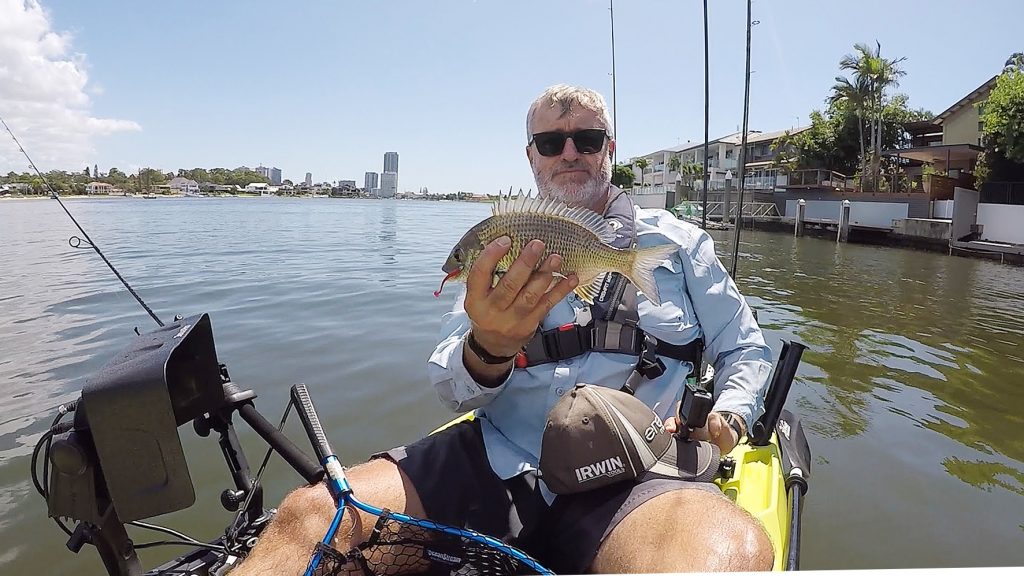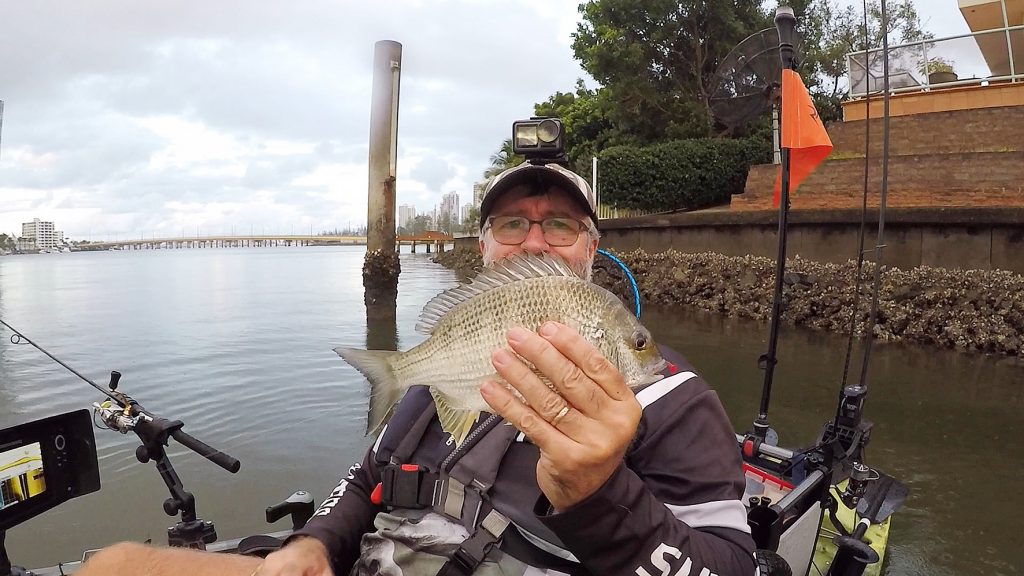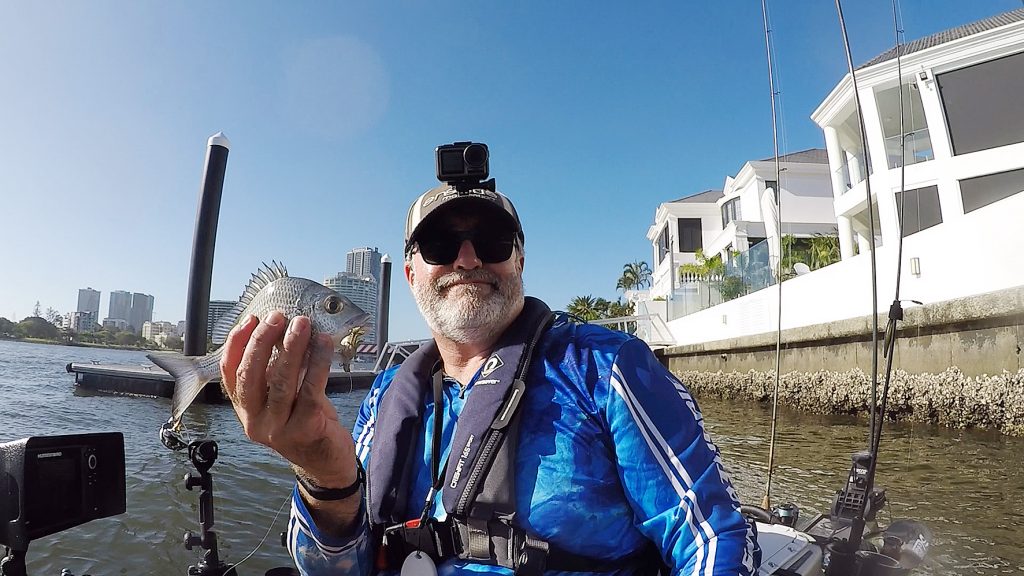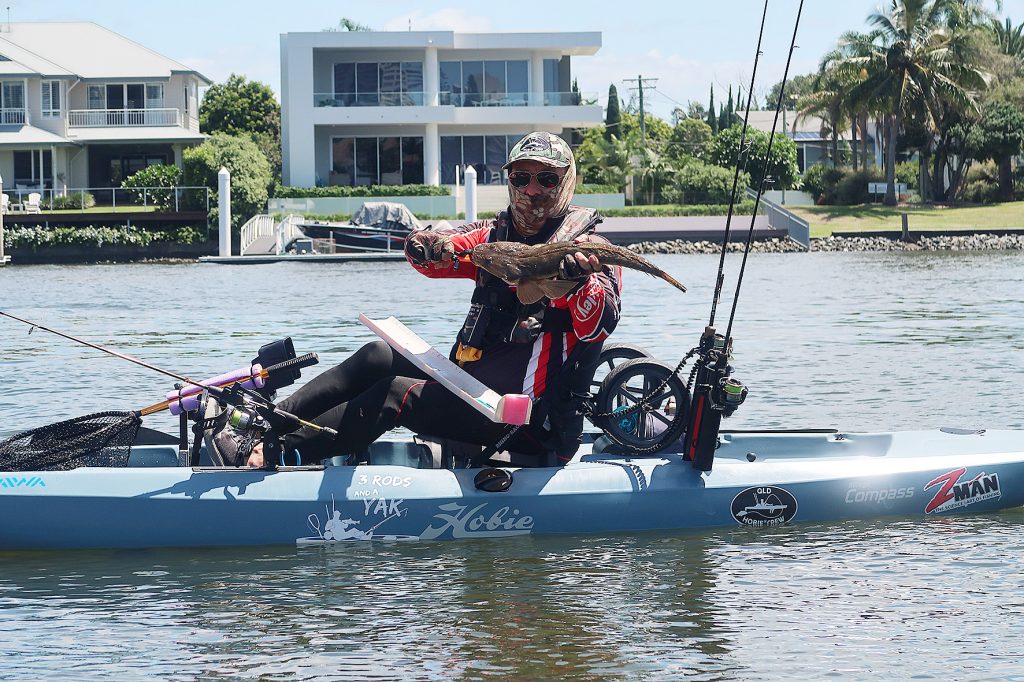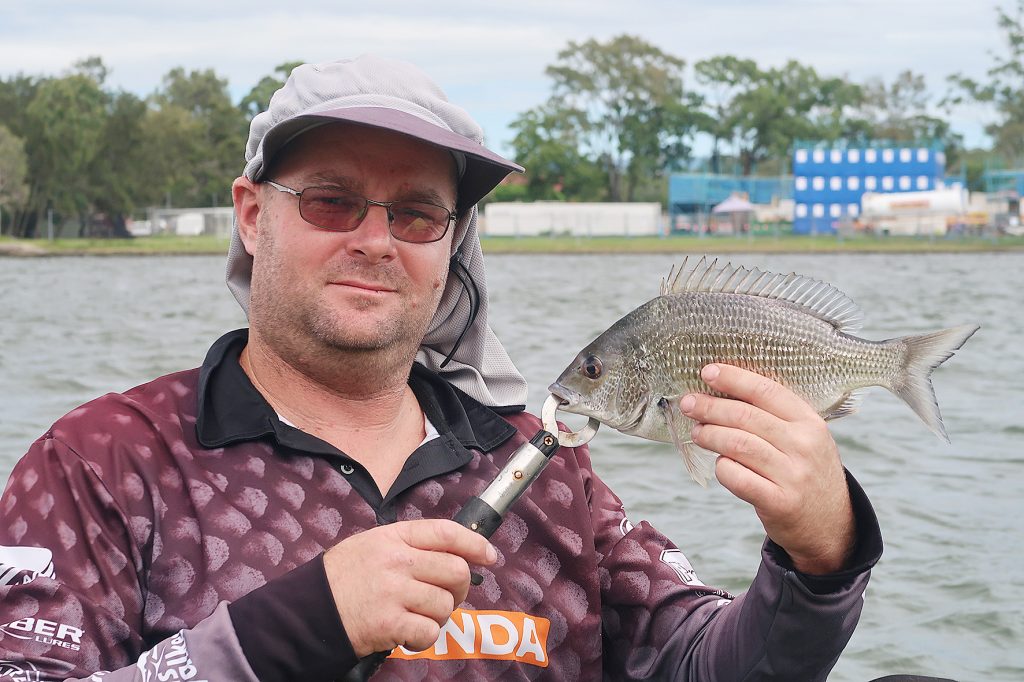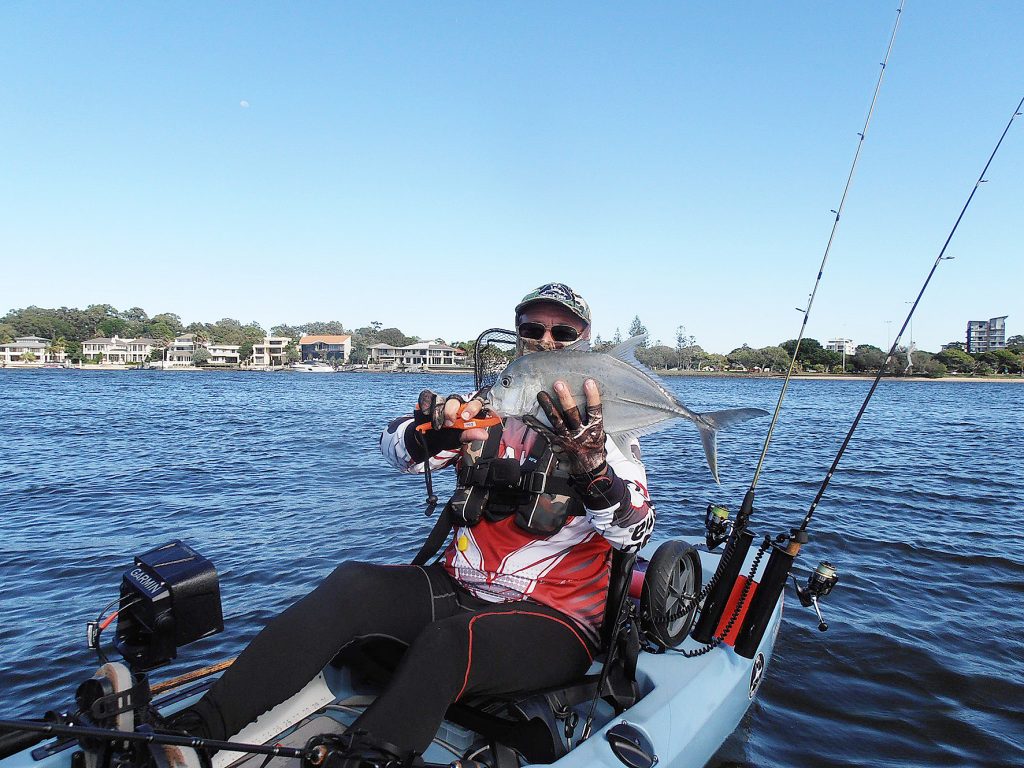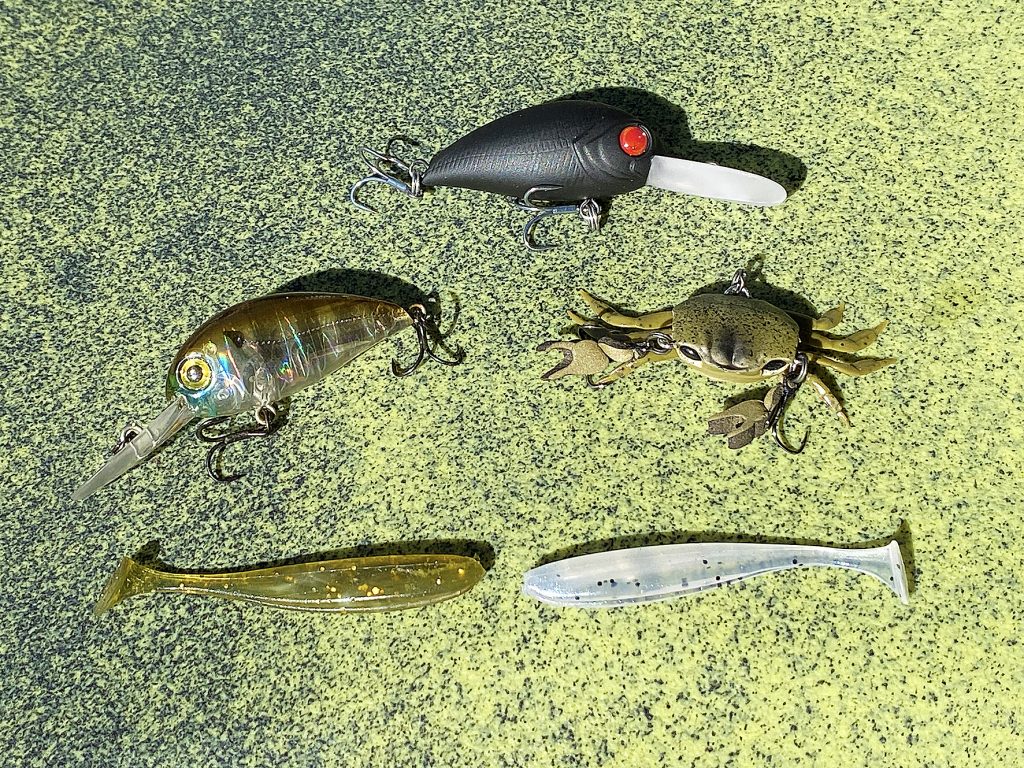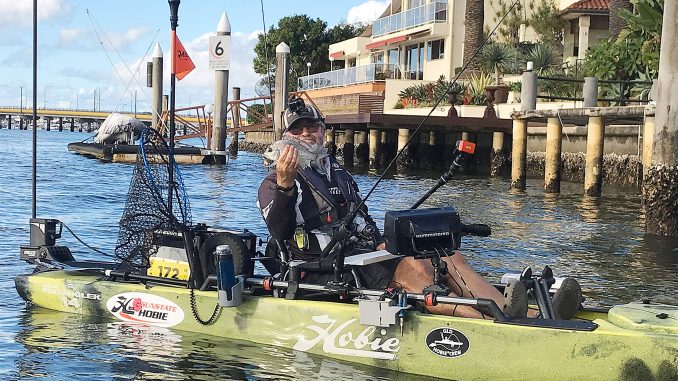
by Troy Brown •
My latest kayaking adventure took me to the busy Nerang River, specifically the area just upstream of the Sundale Bridge. With a multitude of launch sites including boat ramps and sandy shores in the nearby canals, this area is a haven for the pontoon fishing fanatic.
Fishing from boats can be really fun, but nothing beats a kayak for truly immersing yourself in the environment. It’s difficult to feel otherwise when there are mere inches between you and the water, and the kayak is more an extension of your body than it is a boat. For this reason alone, when someone asks me about taking up kayak fishing, I always recommend they invest in the best hull they can afford. This is not a sport many try and then walk away from, so it’s important to make your first kayak something which will stand the test of time.
There is no true ‘one size fits all’ solution for kayak fishers, with details such as speed, comfort, stability, layout and storage valued differently by each angler. Despite this, there is one feature which few kayakers would deny being the most helpful: the pedal drive.
Pedal drives take a couple of forms, with the best known being the Mirage Drive system offered by Hobie. These ‘flipper’ style drives are extremely versatile and efficient, delivering shallow water operation which is difficult to achieve with other systems. These drives have developed significantly over recent years, with new features such as kick-up fins and the Mirage Drive 360, which provides a unrivalled level of kayak manoeuvrability.
Most of the opposition comes in the form of a propeller drive system, which may lack the extreme shallow water ability of a fin-style drive, but does have the attraction of instant reverse and budget-friendly pricing.
Regardless of your choice of pedal drive system, the common benefit is the ability to fish hands-free. Apart from an occasional direction change by flicking the rudder, pedal kayaks effectively release your hands from the paddle and leave them firmly planted on your fishing rod. This means more time is spent casting, working your lures and fighting your fish, rather than reaching for a paddle to maintain position. When fishing the edges of pontoons, the advantage this provides cannot be stressed enough, as a momentary loss of concentration to correct your drift can result in a lost fish.
In these tight structures, you need to be aware of your surroundings to ensure that you are respectful of owners’ property. Floating platforms may be great structure for your favourite fish, but placing any part of yourself on a pontoon is akin to walking around someone’s backyard uninvited.
With the water cooling, my key targets around the pontoons are the ‘Warwick Cappers’ of the sea: bream. Just like Warwick, who loved to strut around in short so tight they caused his neck to bulge, you either love these fish, or love to make fun of them. Bream fishers espouse the fighting qualities of a solid bream around structure, especially when fishing with ultra-light outfits. Other anglers hate these ‘chickens of the sea’, calling them such derogatory names as ‘poo eaters’, while photos of men sitting together in bath tubs seem to be a common meme for those who chase bream.
Good-natured jibes aside, bream present one of the best pound-for-pound targets on light gear, and those anglers who chase other species are missing a wonderful hunt. I used to question the sanity of bream tournament competitors, but time spent chasing these fish with lures has provided me with a true admiration for the competitive anglers who regularly produce quality catches during tournaments.
Kayak fishing is ideally suited to chasing these wily characters, as bream are notoriously easy to spook and can be tentative with lures, especially around the heavily-fished waters of the Gold Coast. These fish have seen more lures than Steve Morgan, so enticing them from their lairs can be tougher than pulling me away from an all-you-can-eat dessert bar. The reputation of bream is somewhat sullied by the ease of catching these silver ghosts on bait, but when you start chasing them with lures, it’s easy to appreciate why bream tournaments are so popular.
TACKLE
For more hook-ups and a truly enjoyable fight, you need to come equipped with modest weapons. This is no place for mangrove jack gear! You’ll want rods in the 1-2kg range and reels spooled with 3-6lb main line to increase the odds of a hook-up. High quality braided lines with light fluorocarbon leaders of 4-6lb are a nice compromise for easy casting, a reasonable level of abrasion resistance and superior feel. For the ultimate in fun, discard the braid and instead spool your reel with 100% fluorocarbon. With a light fluorocarbon line straight-through (there is obviously no need for a leader), the hook-ups are pure adrenaline rushes as you attempt to pull these little maulers away from oyster-encrusted pylons and pontoons. The light fluorocarbon line can be a challenge when casting, but the reward will be more hook-ups, some bust-ups and ultimately more fish.
TECHNIQUE
There are many ways to approach fishing around pontoons, but a pedal kayak makes execution far easier than juggling a rod and paddle. One of the simplest and most productive methods is to start at the top of a pontoon, letting the tide bring you down the side of the structure. Cast forward and bury your rod tip deep, forcing your line down below the base of the pontoon. With the tide pulling you along and the line starting forward of the structure and about a 45° angle from the kayak, the tidal drift will move you along the edge of the strike zone while your lure is dragged under the shaded structure.
Deep below the bream is in its favourite spot, hiding in a shaded area and confidently awaiting its prey. When your lure comes darting under the pontoon, all the bream sees is an easy meal. While keeping your rod tip low, a couple of small flicks and pauses is all that is necessary to excite the bream into action.
Small paddle-tail lures in the 50-70mm range are perfect for this technique and with a decent tidal flow, very little input is required from the angler. You need to be ready for the strike, as the fish will dart for cover once it is hooked and nearby pylons are a likely target. The fish also frequently come high in the water column, so if you don’t keep that rod tip low, your line will run on the underside of the pontoon and a bust-off is milliseconds away. One momentary loss of concentration and the battle is lost.
Kayaks have an exceptional advantage in canals, as there is no noisy motor or even the hum of an electric to reduce the aggression of the fish. However, despite the stealth of even the best pedal kayaks (some low quality propeller drives are infuriating loud), you still need to be conscious of your proximity to the fish. Passing too near the area will shut down fish unless they are aggressively feeding, so use that pedal drive to ensure you are not passing too closely or throwing a shadow near where the fish lurk. For this reason, I am not a fan of trolling lures past jetties. Most people I’ve watched trolling tend to hold a relatively straight line, so when they bring a lure beside the structure the passing kayak has already spooked the fish. Trolling has its place, but it is also a boring way to target a fish which is otherwise incredible sport.
HARDBODIED LURES
Instead of trolling, a couple of techniques with hardbodied lures are very successful on bream. My preference is for small hardbodied cranks such as the Atomic Hardz or Berkley Fat Dogs, but there are a multitude of exceptional lures available for the task.
I suggest you work both ends and the long side of each pontoon you approach. Once again, I like working the up-current side of the pontoon at a 45° angle, drifting a few metres away from the edge and casting across the front face. I then throw the rod tip low and perform a simple slow roll along the short side of the pontoon, before pulling it low under the lip and out towards the kayak. Once I’ve worked the top of the pontoon, I cast well forward of the pontoon, drift to the other end and then start a steady retrieve along the long outside edge. With high quality cranks, there is typically no requirement for any fancy rips and stalls, as the hypnotic sway will entice a bream to dart from cover and strike.
Working the back side of the pontoon is often the most productive, but can require the greatest casting precision. Bream often lurk in the calmer water behind the structure, silently feeding off the pontoon and also waiting to hijack a meal which washes down with the tide.
The undisputed king of bream lures is the Cranka Crab. It’s also possibly the simplest lure to use, as there is little requirement for the angler to put ‘action’ into the lure and typically will only require a subtle wind to elicit a strike. As effective as they are, I prefer small soft plastics or cheaper crab imitations, not just because I baulk at the price of these amazing lures, but also because the soft plastics make me work a lot harder for my catch. I do like fishing crabs occasionally, even resorting to buying cheap models, painting them myself, custom-weighting and upgrading hooks etc. After making all the modifications they possibly cost more than a Cranka, but catching fish on something you have heavily modified is extremely satisfying. I am yet to make anything as effective as the Cranka though, so if you want to win a bream tournament never borrow a crab from my tackle box!
When fishing with any of these crabs, I don’t mind being a little brutal about how I toss them at structure. If there is no danger of damaging a home owner’s property, I tend to fire the crabs with some gusto, as a light slap when your crab touches a padded pylon can fire up an angry bream. The downside is that if you hit a rough edge, your crab may need some repairs or even worse, you will watch your valuable lure sink into a watery grave without any line attached.
ROCK WALLS
While the floating platforms are mostly productive, don’t be fooled into ignoring one of the best fish hang-outs available. Many of these waterways have significant rock walls or sheer cement edges, which provide safe havens for the fish and vast shadows at different times of the day. I’ve found working those walls with direct sunlight to be unproductive, but when the edge of the water is in deep shadow, it is a perfect spot for bream to ambush your lure.
Casting a lightly weighted plastic up into the tide, letting it settle slowly to the bottom while continuously slow rolling it back to the kayak is a deadly technique. Often you will catch more fish on the wall edge than under the pontoons. Skipping a crab into the drop-off is very effective, although the rocky edges will occasionally claim your expensive lure. Still, when that big strike comes, you’ll quickly forget about the cost of the lures you’ve lost to snags.
One of my friends recently noted that I never spend long working any piece of structure. This was on a day where I had caught some fish and he was struggling a little. He is a very good angler, but because he rarely targeted fish in canals he was not having his best day. I had never paid a lot of attention to how I fish those areas, but his words resonated with me and it explained perhaps why I was having a rare day of boating more fish than he was. Generally, if I don’t catch a fish after one or two casts at ANY piece of structure, I will move on. Why?
The fact is that bream seem to be either switched on, switched off or perhaps just not there! If you cannot see fish, or can see them and not entice them to strike, the situation will not readily change and you should move along. Often you can drift down 50m, work some other areas, return and then find the previously shut-down fish will maul your lure. Bream can be very fickle and I generally find two casts at the same spot is perhaps one too many. The same applies to lure choice; on some days bream love crabs, but on other days you’re better off working a hard crank or soft lure.
Having fished from many different kayaks, starting at nimble 9ft paddle hulls up to the insanely outfitted Hobie Pro Angler 360, I cannot overstate the value of using a pedal kayak for this style of fishing. It is close quarters stuff and the fish are unforgiving, so having your hands free to fight while your feet maintain position is an incredible advantage. There are many skilled anglers whose ability to catch fish makes even the most cumbersome kayak seem manageable, but for mere mortals such as myself, the increased focus I achieve with pedal propulsion is a game changer.
Regardless of your choice of brand, if you invest in a well manufactured pedal-driven kayak, you will take your fishing to the next level. If your budget permits, find your nearest dealer and ask for a demonstration. Better still, if you are a member of one of the many kayak fishing pages on social media, shout out to fellow members and do a kayak swap for a day of fishing. The best way of finding a pedal fishing kayak which suits you is to actually fish from one, rather than just pedalling a few metres up a river. If your budget allows it and you love fishing tight into the areas where fish are holding, a high quality pedal kayak will dramatically improve your enjoyment of this sensational sport.

